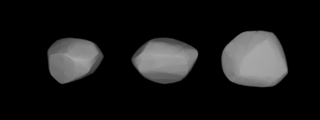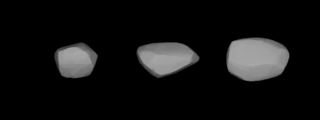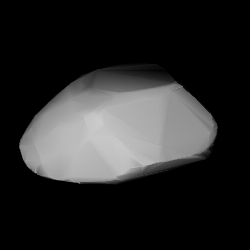3412 Kafka, provisional designation 1983 AU2, is an asteroid from the inner regions of the asteroid belt, approximately 6 kilometers in diameter. It was discovered on 10 January 1983, by American astronomers Randolph Kirk and Donald Rudy at Palomar Observatory in California, United States. The asteroid was named after writer Franz Kafka.

143 Adria is a fairly large main-belt asteroid that was discovered by Austrian astronomer Johann Palisa on 23 February 1875, at the Austrian Naval Observatory, and named after the Adriatic Sea, on the coast of which the discovery was made. This dark-coloured asteroid has probably a primitive carbonaceous chondritic composition.

224 Oceana is an asteroid from the asteroid belt. It was discovered by Austrian astronomer Johann Palisa on 30 March 1882, in Vienna. It was named after the Pacific Ocean. Based upon its spectrum, it is classified as an M-type asteroid, but is not metallic.

228 Agathe is a stony main belt asteroid, about 9 kilometers in diameter. It was discovered by Johann Palisa on 19 August 1882 at Vienna Observatory, Austria. Photometric observations during 2003 showed a rotation period of 6.48 ± 0.01 hours with a brightness variation of 0.27 ± 0.03 in magnitude. An earlier study yielded results that are consistent with these estimates. Agathe is the lowest numbered asteroid to have an Earth-MOID as low as 0.657 AU (98.3 million km). On 23 August 2029 the asteroid will be 0.659 AU (98.6 million km) from Earth.

235 Carolina is a sizeable Main belt asteroid. It was discovered by Austrian astronomer Johann Palisa on 28 November 1883 in Vienna, and was named after Caroline Island, now part of Kiribati in the Pacific Ocean. This asteroid is orbiting the Sun at a distance of 2.88 AU with a period of 4.89 yr and an eccentricity (ovalness) of 0.06. The orbital plane is tilted at an angle of 9.0° to the plane of the ecliptic.

242 Kriemhild is a main belt asteroid that was discovered by Austrian astronomer Johann Palisa on 22 September 1884 in Vienna and was named after Kriemhild, a mythological Germanic princess, by Moriz von Kuffner, a Viennese industrialist and sponsor of astronomy.
255 Oppavia is a sizeable Main belt asteroid. It was discovered by Austrian astronomer Johann Palisa on 31 March 1886 in Vienna and was named after Opava, a town in the Czech Republic, then part of Austria-Hungary, where Palisa was born. It is orbiting the Sun at a distance of 2.75 AU with an orbital eccentricity (ovalness) of 0.077 and a period of 4.55 yr. The orbital plane is inclined by an angle of 9.47° to the plane of the ecliptic.

273 Atropos is a typical Main belt asteroid that was discovered by Austrian astronomer Johann Palisa on 8 March 1888 in Vienna.

286 Iclea is a large main-belt asteroid. It was discovered by Austrian astronomer Johann Palisa on 3 August 1889 in Vienna, and named for the heroine of Camille Flammarion's astronomical romance Uranie. This object is orbiting the Sun at a distance of 3.19 AU with a period of 5.711 years and an orbital eccentricity (ovalness) of 0.029. The orbital plane is tilted at an angle of 17.9° to the plane of the ecliptic.
538 Friederike is a minor planet orbiting in the asteroid belt. It is a member of the Hygiea family of asteroids.

572 Rebekka is a minor planet orbiting the Sun, which was discovered on September 19, 1905, by a German astronomer Paul Götz in Heidelberg. It was named after a young lady from Heidelberg, and may have been inspired by the asteroid's provisional designation 1905 RB.
585 Bilkis is a minor planet, specifically an asteroid orbiting in the asteroid belt. It was discovered by German astronomer August Kopff in 1906 February and was given the Koran name for the Queen of Sheba. Photometric observations at the Palmer Divide Observatory in Colorado Springs, Colorado in 2006–7 were used to build a light curve for this object. The asteroid displayed a rotation period of 8.5742 ± 0.0005 hours and a brightness variation of 0.40 ± 0.02 in magnitude.

632 Pyrrha is a minor planet orbiting the Sun.
652 Jubilatrix is a minor planet, specifically an asteroid orbiting in the asteroid belt. It was discovered on 4 November 1907 by Austrian astronomer Johann Palisa, and was named in honor of the 60th anniversary of the reign of Franz Joseph. The asteroid is orbiting at a distance of 2.55 AU with a period of 4.08 yr and an eccentricity of 0.127. It is a member of the Maria dynamic family. Photometric observations provide a rotation period of 2.6627±0.0001 h with a brightness variation of 0.27±0.03 in magnitude.
687 Tinette is a minor planet, specifically an asteroid orbiting primarily in the asteroid belt. It was discovered by Austrian astronomer Johann Palisa on 16 August 1909 from Vienna and was given the preliminary designation 1909 HG.
730 Athanasia is a background asteroid from the inner regions of the asteroid belt, approximately 4.5 kilometers in diameter. It was discovered by Austrian astronomer Johann Palisa at the Vienna Observatory on 10 April 1912. The presumed stony S-type asteroid has a rotation period of 5.7 hours and is likely very elongated in shape. It was named Athanasia, the Greek word for "immortality".
774 Armor is a minor planet orbiting in the main belt. It was discovered on 13 December 1913, in Paris by French astronomer Charles le Morvan and was named after the Celtic region of Armorica. The asteroid is orbiting at a distance of 3.05 AU with a period of 5.32 yr and an eccentricity of 0.169. The orbital plane is inclined by an angle of 5.56° to the plane of the ecliptic.
833 Monica is a minor planet orbiting the Sun. Measurements of the lightcurve made in 2010 give a rotation period of 12.09 ± 0.01 hours. It has a diameter of 21.2 km.
839 Valborg is a mid-sized S-type Eunomian asteroid. Its diameter is about 20 km, its albedo of 0.353 is very high for an asteroid. Its rotation period is 10.366 hours.
996 Hilaritas is a Themistian asteroid. It was discovered in 1923 by Austrian astronomer Johann Palisa. Following Palisa's death in 1925, this asteroid was named for a "happy or contented mind"; qualities associated with the discoverer.









